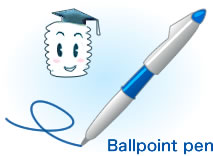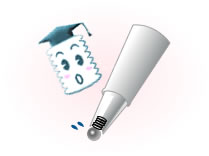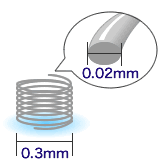
Episode 17: Very Small “Springs”
Hello everyone.
We are firmly heading into the outdoor season when the mountains are at their finest. Autumn is also a time for eating. It might be a dangerous time for those of us who are watching our diets.
This time, I would like to introduce you to very small “springs.” They are extremely small springs. Did you know that springs are also used in the tips of ballpoint pens?
* Not all ballpoint pens use springs, however.
If you think about the springs used in ballpoint pens, the first thing you certainly would think of is springs composing a knock type ballpoint pen.
The core shaft is ejected from the tip of the ballpoint pen by pressing the top of the pencil. When you finish writing, or you press the top or another portion (a projection), the core shaft is drawn back inside.
Also, when you put your ballpoint pen in your pocket, a spring is at work to hold the ballpoint pen in your pocket so it will not fall out.

I am certain anyone would understand just exactly the concepts of springs I am talking about.
However, the springs used in the portion of the ballpoint pen is slightly difficult to imagine, I think. At any rate, ordinarily, we do not see this spring very often.

To write using a ballpoint pen, a small metallic ball projecting slightly from the tip of the core rolls over the paper. The ballpoint pen core shaft contains ink. When you write on paper, there is a large pressure between the paper and metallic ball. The metallic ball is rotated by this pressure. The leading end coated with ink while it rolls leaves the ink on the paper.
Also, a very small spring is used to push this metallic ball from the inside of the core shaft.
Why is such a spring necessary?
The reason is that when you turn the ballpoint pen upside down to write, the ink will flow away from the leading end causing the metallic ball to slightly float.
To avoid this unwanted state, a very small spring exists inside the core shaft to firmly press the metallic ball.
Just about how fine is this very small spring?
The diameter of the metal forming this spring is approximately 0.02 mm. When this metal wire is formed into a coil, the diameter of the spring is approximately 0.3 mm. There are even finer springs out there. Think of a wound metal wire as fine as a human hair.
These very small springs are used in electrical testing devices (probe tests) that check whether semiconductor circuits have been correctly formed. In the future, we’ll see more use of very fine springs in precision components.

That’s it for now. Very small springs are used in the leading ends of water-based ballpoint pens in particular. Now you won’t look at ballpoint pens the same way ever again.
See you next time!
Written by Banekko (a child of spring)

